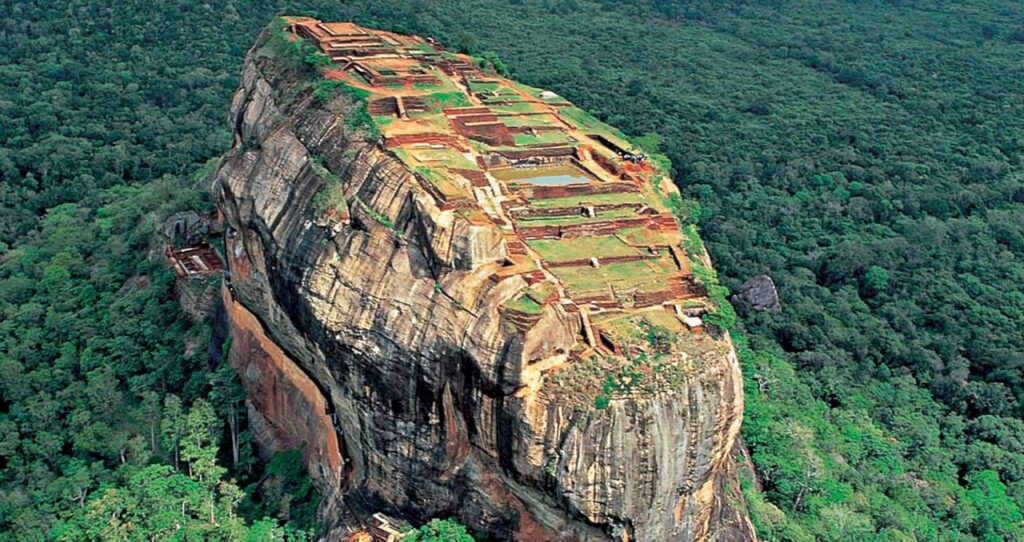
Pidurangala
Pidurangala is a massive rock located a few kilometers north of Sigiriya. There is an ancient Buddhist temple situated on the rock. Both the Sigiriya Rock Fortress and the Pidurangala Rock have an interconnected history. It is believed that King Kashyap while building the Sigiriya Fortress, moved all monks who were living around Sigiriya to the Pidurangala monastery.
The monastery consists of many ritual buildings which are: an ancient stupa, a chapter house, an image house, a Bodhidharma, a preaching hall, a sangharama (bhikku residence building), and inscriptions. A stupa to the left of the building is said to be where King Kashyap was buried.
Climbing the Pidurangala rock is tougher than climbing Sigiriya Rock as there is not any clear path to the top. Uneven steps lead to an area of a vast number of boulders that the climbers must encounter to reach the top. The top of the rock offers a fabulous view of the Sigiriya Rock and surrounding places. Those who don’t possess sound physical health must avoid an attempt to climb Pidurangala as climbing requires a lot of stamina.
Ritigala
Ritigala is a mountain located in central Sri Lanka, 43 km away from the city of Anuradhapura. It houses a Buddhist monastery on the top and contains ruins and inscriptions which date back to the 1st century BCE.The mountain is 6.5 km in length and divided into northern and southern blocks by Maha-Degala Gorge.
The mountain has four peaks that rise steeply from the surrounding plains. The highest peak is Ritigala Kanda in the southern block. Elevated by 766 M above sea level, it is taller than other mountainous tourist attractions such as Sigiriya, Dambulla, and Mihintale.
There are various beliefs about Ritigala. One of them is that powerful medicinal herbs are found near the crest. An herb called “Sansevi” is believed to have the power of conferring long life and curing all human pain.
Aukana Buddha Statue
The Aukana statue is a standing statue of the Buddha located in the village, Aukana near Kekirawa in North Central Sri Lanka. The Avukana statue is one of the best examples of a standing statue constructed in ancient Sri Lanka. It is now a popular tourist attraction. The specialty of the statue is that it is carved out of a large granite rock face, not fully separated from the rock. A narrow strip of rock still holds the statue.
The pedestal on which the Buddha stands, in the form of a lotus flower, was carved separately and positioned under the statue. The statue alone is 38 feet 10 inches tall, and with the pedestal, the total height of the Avukana statue reaches 42 feet.
Nalanda Gedige
NalandaGedige is an ancient complete stone temple near Mataleconstructed in between the 8th and 10th centuries with Dravidian architecture. According to some scholars, this building is a Dravidian architecture dedicated to a Mahayana cult with pronounced Tantric learning.Its design is that of a typical Hindu temple with a mandapa, an entrance hall, a short passage to a bare cello, and an ambulatory round the holy center. According to an unearthed pillar inscription, Nalanda Gedige was a Buddhist monastery.
Mihintale
Mihintale is a 1000 ft. tall mountain peak 12.5 km east of Anuradhapura in Sri Lanka. Thera Mahinda, the son of the Emperor Asoka of India came to Sri Lanka from India and preached the Buddhist doctrine on this peak to King Devanampiyatissa. Hence this spot where the meeting took place is revered by the Buddhists of Sri Lanka. Today Mihintale is considered the cradle of Buddhism in Sri Lanka.
Matale Alu Viharaya
The Aluvihare Rock Temple also called MataleAluViharaya is a sacred Buddhist temple located in Aluvihare, Matale District of Sri Lanka. It is located 30 km north of Kandy on the Matale-Dambulla road. The history of Aluvihare Rock Temple dates back to the 3rd century B.C to the period of King Devanampiyatissa. It is believed that after the introduction of Buddhism in Sri Lanka, the King built the dagoba, planted the Bo sapling, and founded the temple.
